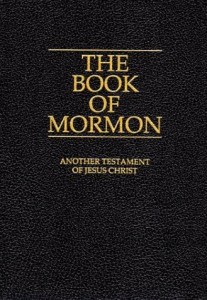Journey of Faith tracks the journey started in 600 bc by the Israelite Prophet Lehi and his family as they made their exodus from Jerusalem across the Arabian desert to the coast, and from there to the New World. Lehi’s son, Nephi, begins the account in 600 bc, preserving it by engraving on metal plates. The narrative did not come to light until the 1820s, when by divine revelation, Joseph Smith was directed to the plates and unearthed them from a hill in upstate New York. From them he translated the Book of Mormon: Another Testament of Jesus Christ.
Printing the Book of Mormon
In preparation for printing the completed translation,[1] a fair copy was made, mostly by Oliver Cowdery. Royal Skousen, who has spent many years working with the extant parts of the original manuscript and the printer’s manuscript owned by The Church of Jesus Christ of Latter-day Saints, provides us with the steps taken to transmit the text.
- the scribe copies the text (the printer’s manuscript)
- the 1830 printer sets the type from manuscript, as follows:
- from the printer’s manuscript, for five-sixths of the text:
- 1 Nephi 1–Helaman 13
- Ether 1–Moroni 10
- from the original manuscript, for one-sixth of the text:
- Helaman 13–Mormon 9
- from the printer’s manuscript, for five-sixths of the text:
- There is also evidence that for several of these stages the copying process was proofed:
- the scribe read back to Joseph Smith what had just been written down in the original manuscript
- after copying, the printer’s manuscript was frequently proofed against the original manuscript (sometimes by a different scribe)
- the 1830 printed sheets were proofed against the manuscript used to set the type, although in one case the sheet was set from the printer’s manuscript but then checked against the original manuscript (gathering 22, covering Alma 41–46).[2]
The press chosen to print the Book of Mormon was that owned by Egbert B. Grandin of Palmyra, New York. The main compositor was John Gilbert. Joseph stipulated that the initial print-run was to be 5,000, which was an unusually large amount and required special handling.
When the printer was ready to begin the typesetting, about the middle of August, Martin Harris was notified. Hyrum Smith then brought the first installment of the “printer’s manuscript” numbering 24 pages. He had them buttoned under his vest and coat for security. The pages were closely written and legible, but Gilbert said that every chapter was virtually one solid paragraph as there was not a punctuation mark from beginning to end.”[3]
On 26 March, 1830, the Book of Mormon was published. On 6 April, 1830, The Church of Jesus Christ of Latter-day Saints was officially organized. Of the coming forth of the Book of Mormon, Joseph said:
The Book of Mormon (“the stick of Joseph in the hands of Ephraim”) had now been published for some time, and as the ancient prophet had predicted of it: “It was accounted as a strange thing.” No small stir was created by its appearance; great opposition and much persecution followed the believers of its authenticity; but it had now come to pass that truth had sprung out of the earth; and righteousness had looked down from heaven—so we feared not our opponents, knowing that we had both truth and righteousness on our side; that we had both the Father and the Son, because we had the doctrines of Christ, and abided in them; and therefore we continued to preach, and to give information to all who were willing to hear.[4]
Dissemination and Reception of the Book of Mormon
Reaction to the Book of Mormon has never been lukewarm, and never more so was this borne out than at its first appearance. Matthew Roper, in surveying the huge collection that he with others assembled for the Maxwell Institute remarked:
Early literature relating to the Book of Mormon appeared in a highly partisan atmosphere of religious polemic common to the time. Early publications treated the Book of Mormon with contempt and ridicule even before it came off the press. “For some time past,” noted the editor of the Wayne Sentinel on 26 June 1829, “much speculation has existed, concerning a pretended discovery, through superhuman means, of an ancient record, of a religious and a divine nature and origin, written in ancient characters, impossible to be interpreted by any to whom the special gift has not been imparted by inspiration. It is generally known and spoken of as the ‘Golden Bible.’ Most people entertain an idea that the whole matter is the result of a gross imposition and a grosser superstition.” The term Gold Bible was not intended as one of respect. As Abner Cole, the editor of the Palmyra tabloid the Reflector, explained, “The appellation of ‘Gold Bible,’ is only a cant cognomen,” a nickname given to the Book of Mormon by “revilers and unbelievers—by way of derision.”[5]
However, missionaries of The Church of Jesus Christ of Latter-day Saints now had a book which they could take with them as they traveled throughout the United States and even to England and Europe. As BYU Professor Larry Porter concludes, “With five thousand copies of the Book of Mormon available to them as an immediate means of promulgating the restored gospel, missionaries of the Church taught from this ancient scripture to aid in the conversion of first hundreds, and then thousands to the message of salvation.”[6]
[1] Details on the discovery and translation of the Book of Mormon.
[2] Royal Skousen, “History of the Critical Text Project of the Book of Mormon,” in Uncovering the Original Text of the Book of Mormon, ed. M. Gerald Bradford and Alison V. P. Coutts (Provo, UT: FARMS, 2002).
[3] “History of Joseph Smith.” Times and Seasons (Dec 1842): 4:22–23. See Larry C. Porter, “The Book of Mormon: Historical Setting for Its Translation and Publication,”.
[4] Porter, “The Book of Mormon.”
[5] Matthew Roper, “Early Publications on the Book of Mormon,” Journal of the Book of Mormon and Other Restoration Scripture 18/2 (2009): 38–49. See the full collection.
[6] Porter, “The Book of Mormon.” For more on reaction to the publication of the Book of Mormon, see Richard H. Cracroft, “‘Had for Good and Evil’: 19th-Century Literary Treatments of the Book of Mormon,” Journal of Book of Mormon Studies 12/2 (2003): 14–19.


